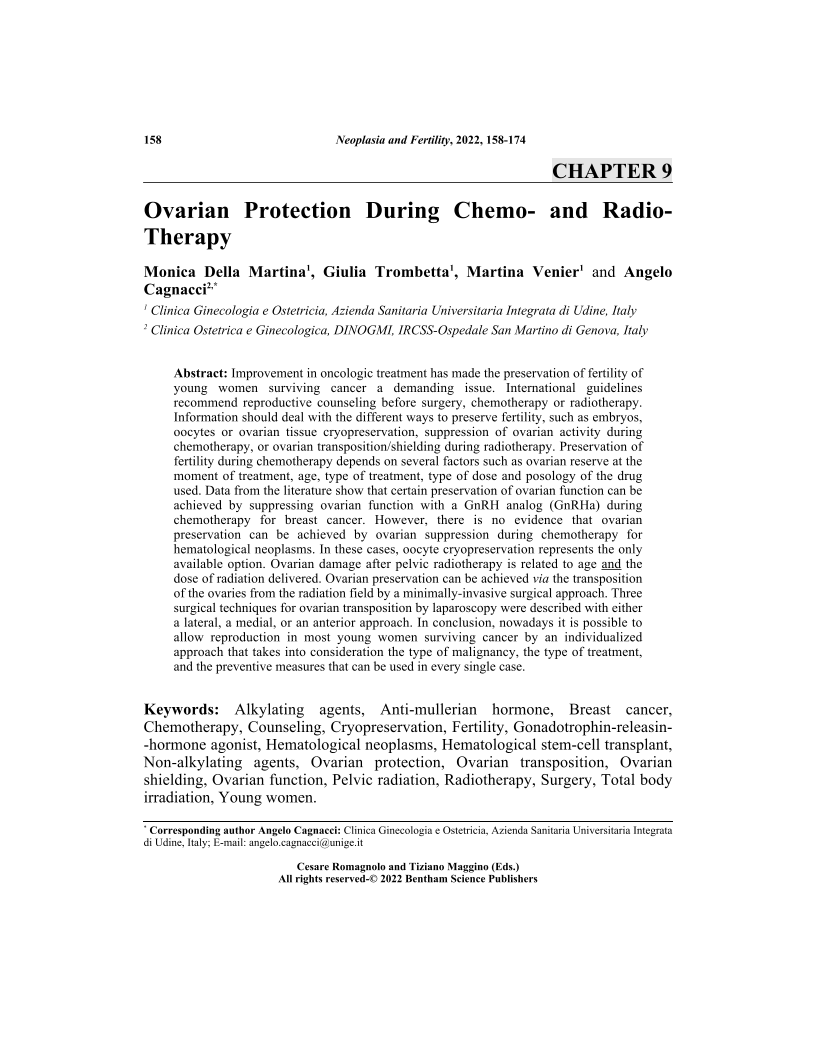Ovarian Protection During Chemo- and Radio-Therapy

- Authors: Monica Della Martina1, Giulia Trombetta2, Martina Venier3, Angelo Cagnacci4
-
View Affiliations Hide Affiliations1 Clinica Ginecologia e Ostetricia, Azienda Sanitaria Universitaria Integrata di Udine, Italy 2 Clinica Ginecologia e Ostetricia, Azienda Sanitaria Universitaria Integrata di Udine, Italy 3 Clinica Ginecologia e Ostetricia, Azienda Sanitaria Universitaria Integrata di Udine, Italy 4 Clinica Ostetrica e Ginecologica, DINOGMI, IRCSS Ospedale San Martino di Genova, Italy
- Source: Neoplasia and Fertility , pp 158-174
- Publication Date: September 2022
- Language: English
Ovarian Protection During Chemo- and Radio-Therapy, Page 1 of 1
< Previous page | Next page > /docserver/preview/fulltext/9789815050141/chap9-1.gif
Improvement in oncologic treatment has made the preservation of fertility of young women surviving cancer a demanding issue. International guidelines recommend reproductive counseling before surgery, chemotherapy or radiotherapy. Information should deal with the different ways to preserve fertility, such as embryos, oocytes or ovarian tissue cryopreservation, suppression of ovarian activity during chemotherapy, or ovarian transposition/shielding during radiotherapy. Preservation of fertility during chemotherapy depends on several factors such as ovarian reserve at the moment of treatment, age, type of treatment, type of dose and posology of the drug used. Data from the literature show that certain preservation of ovarian function can be achieved by suppressing ovarian function with a GnRH analog (GnRHa) during chemotherapy for breast cancer. However, there is no evidence that ovarian preservation can be achieved by ovarian suppression during chemotherapy for hematological neoplasms. In these cases, oocyte cryopreservation represents the only available option. Ovarian damage after pelvic radiotherapy is related to age and the dose of radiation delivered. Ovarian preservation can be achieved via the transposition of the ovaries from the radiation field by a minimally-invasive surgical approach. Three surgical techniques for ovarian transposition by laparoscopy were described with either a lateral, a medial, or an anterior approach. In conclusion, nowadays it is possible to allow reproduction in most young women surviving cancer by an individualized approach that takes into consideration the type of malignancy, the type of treatment, and the preventive measures that can be used in every single case.
-
From This Site
/content/books/9789815050141.chap9dcterms_subject,pub_keyword-contentType:Journal -contentType:Figure -contentType:Table -contentType:SupplementaryData105

